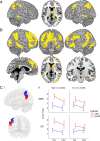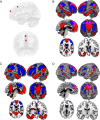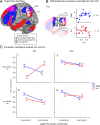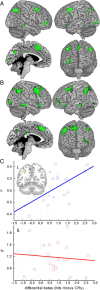The inferior parietal lobule and recognition memory: expectancy violation or successful retrieval?
- PMID: 20181590
- PMCID: PMC2844718
- DOI: 10.1523/JNEUROSCI.4225-09.2010
The inferior parietal lobule and recognition memory: expectancy violation or successful retrieval?
Abstract
Functional neuroimaging studies of episodic recognition demonstrate an increased lateral parietal response for studied versus new materials, often termed a retrieval success effect. Using a novel memory analog of attentional cueing, we manipulated the correspondence between anticipated and actual recognition evidence by presenting valid or invalid anticipatory cues (e.g., "likely old") before recognition judgments. Although a superior parietal region demonstrated the retrieval success pattern, a larger inferior parietal lobule (IPL) region tracked the validity of the memory cueing (invalid cueing > valid cueing) and no retrieval success-sensitive lateral parietal region was insensitive to cueing. The invalid cueing response occurred even for correctly identified new items unlikely to trigger substantive episodic retrieval. Within the IPL, although supramarginal and angular gyrus (SMG; AG) regions both demonstrated invalid cueing amplitude elevations, each region differentially coupled with distinct cortical networks when unexpectedly old items were encountered; a connectivity pattern also observed at rest in the same subjects. These findings jointly suggest that the lateral parietal response during recognition does not signify the recovery of episodic content, but is a marker of the violation of memory expectations. A second independent dataset confirmed this interpretation by demonstrating that SMG activation tracked the decision biases of observers, not their accuracy, with increased activation for nondominant recognition judgments. The expectancy violation interpretation of the lateral parietal recognition response is consistent with the literature on visual search and oddball paradigms and suggests that damage to these regions should impair memory-linked orienting behavior and not retrieval per se.
Figures





Similar articles
-
Unexpected novelty and familiarity orienting responses in lateral parietal cortex during recognition judgment.Neuropsychologia. 2013 May;51(6):1061-76. doi: 10.1016/j.neuropsychologia.2013.02.018. Epub 2013 Mar 13. Neuropsychologia. 2013. PMID: 23499719 Free PMC article.
-
Top-down and bottom-up attention to memory: a hypothesis (AtoM) on the role of the posterior parietal cortex in memory retrieval.Neuropsychologia. 2008;46(7):1828-51. doi: 10.1016/j.neuropsychologia.2008.03.022. Epub 2008 Apr 8. Neuropsychologia. 2008. PMID: 18471837 Review.
-
Memory retrieval and the parietal cortex: a review of evidence from a dual-process perspective.Neuropsychologia. 2008;46(7):1787-99. doi: 10.1016/j.neuropsychologia.2008.01.004. Epub 2008 Jan 17. Neuropsychologia. 2008. PMID: 18343462 Free PMC article.
-
Interactions between visual attention and episodic retrieval: dissociable contributions of parietal regions during gist-based false recognition.Neuron. 2012 Sep 20;75(6):1122-34. doi: 10.1016/j.neuron.2012.08.020. Neuron. 2012. PMID: 22998879 Free PMC article.
-
Role of parietal regions in episodic memory retrieval: the dual attentional processes hypothesis.Neuropsychologia. 2008;46(7):1813-27. doi: 10.1016/j.neuropsychologia.2008.03.019. Epub 2008 Apr 8. Neuropsychologia. 2008. PMID: 18439631 Free PMC article. Review.
Cited by
-
Striatal contributions to declarative memory retrieval.Neuron. 2012 Aug 9;75(3):380-92. doi: 10.1016/j.neuron.2012.07.014. Neuron. 2012. PMID: 22884322 Free PMC article. Review.
-
Identifying the Alteration Patterns of Brain Functional Connectivity in Progressive Mild Cognitive Impairment Patients: A Longitudinal Whole-Brain Voxel-Wise Degree Analysis.Front Aging Neurosci. 2016 Aug 17;8:195. doi: 10.3389/fnagi.2016.00195. eCollection 2016. Front Aging Neurosci. 2016. PMID: 27582703 Free PMC article.
-
The angular gyrus: multiple functions and multiple subdivisions.Neuroscientist. 2013 Feb;19(1):43-61. doi: 10.1177/1073858412440596. Epub 2012 Apr 30. Neuroscientist. 2013. PMID: 22547530 Free PMC article. Review.
-
Altered Gray Matter Volume in Stable Chronic Obstructive Pulmonary Disease with Subclinical Cognitive Impairment: an Exploratory Study.Neurotox Res. 2017 May;31(4):453-463. doi: 10.1007/s12640-016-9690-9. Epub 2016 Dec 22. Neurotox Res. 2017. PMID: 28005183
-
Use of explicit memory cues following parietal lobe lesions.Neuropsychologia. 2012 Nov;50(13):2992-3003. doi: 10.1016/j.neuropsychologia.2012.07.037. Epub 2012 Aug 6. Neuropsychologia. 2012. PMID: 22975148 Free PMC article.
References
-
- Allan K, Rugg MD. An event-related potential study of explicit memory on tests of cued recall and recognition. Neuropsychologia. 1997;35:387–397. - PubMed
-
- Benjamin AS, Bjork RA, Schwartz BL. The mismeasure of memory: when retrieval fluency is misleading as a metamnemonic index. J Exp Psychol Gen. 1998;127:55–68. - PubMed
-
- Botvinick MM, Braver TS, Barch DM, Carter CS, Cohen JD. Conflict monitoring and cognitive control. Psychol Rev. 2001;108:624–652. - PubMed
-
- Braver TS, Bongiolatti SR. The role of frontopolar cortex in subgoal processing during working memory. Neuroimage. 2002;15:523–536. - PubMed
-
- Brett M, Anton J-L, Valabregue R, Poline JB. Region of interest analysis using an SPM toolbox. 8th International Conference on Functional Mapping of the Human Brain; June; Sendai, Japan. 2002. Paper presented at.
Publication types
MeSH terms
Grants and funding
LinkOut - more resources
Full Text Sources
Other Literature Sources
Medical
Molecular Biology Databases
